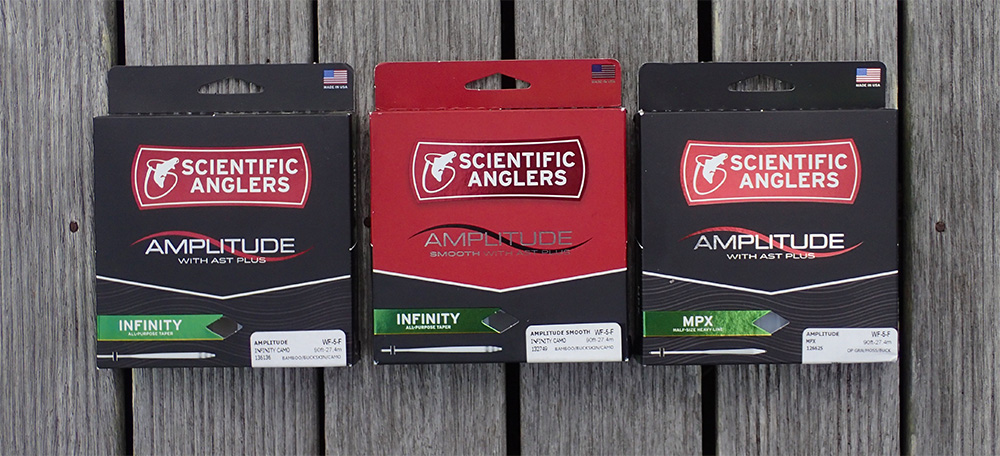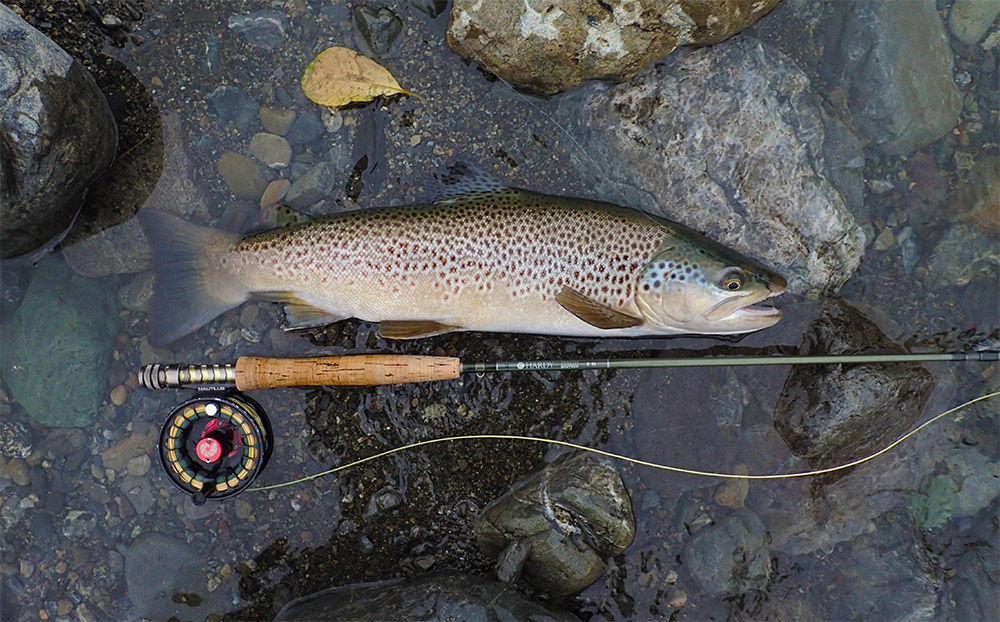About 10 years ago, I switched completely to using Airflo polyurethane fly lines for fresh water because I was tired of PVC lines cracking up after only one season. I also enjoyed the low stretch of Airflo’s products, especially when nymphing at long range.
Over the last year or two I heard glowing reports of the durability and performance of Scientific Angler fly lines, and that the Amplitude series had been scientifically demonstrated to last 7 times longer than regular PVC lines.
I tested the Amplitude Infinity, which is textured, and Amplitude Infinity Smooth, and later the Amplitude MPX, only available in textured. For New Zealand conditions I especially like half-size heavy fly lines with reverse tapers.
Lines with reverse tapers load fast action rods quickly for short casts, but don’t overload them when aerialising more line for long shots. They also provide a great balance of power vs presentation.
The standard Amplitude series is textured, like dimples in a golf ball, to increase shoot ability, and the front taper has a different texture to increase flotation through increased surface area.
The Amplitude Smooth series, as the name suggests, has no texture, and is intended for anglers who don’t like textured lines.
Regardless of whether smooth or textured, the coatings on all Amplitude fly lines contain a fluid lubricant distributed throughout the entire coating that migrates continually to the surface, to maintain shoot ability throughout the life of the fly line.

Amplitude Infinity
The head profile of the Infinity consists of a 7 ft front taper followed by a complex reverse taper that decreases in diameter toward the running line, in three separate tapers that become progressively more acute.
The length of the head on the 5wt version is 49 ft, which is considerably longer than the average 5 wt line.
Head colour of the Infinity is buckskin, with the front 10 ft having olive camouflaging striations - perfect for clear water and spooky New Zealand trout.
Amplitude MPX
The Amplitude MPX has a very different profile to the Infinity. The head on the 5wt MPX is only 35.5 feet long and consists of a 5 foot front taper, a relatively short reverse taper of around 17 feet, a level belly of about 10 foot, then a short rear taper of approximately 3 feet.
The running line of the MPX is optic green and the head is mostly moss green, with the front 7 to 8 feet being buckskin (tan).
Amplitude Infinity during Cicada season
I fished the textured Infinity exclusively during the 2021 cicada season, using a 15 foot tapered leader.
First day on the river, I fished my size 10 Silicone wing cicada on my Hardy Zenith. I was stunned by the amount of line I could shoot with just a couple of false casts. Had I not experienced this myself I would not have believed it possible for a fly line to shoot this well.
It was incredibly easy to cast tight loops with the Infinity, and casting the wind-resistant cicada into a head wind was easier than with other fly lines I’ve used and tested. The shoot ability of the Infinity fly line, together with the long head and reverse taper, made for incredible stability and accuracy at distance. The fairly long front taper resulting in excellent presentation.
During the remainder of the cicada season I fished a #8 Silicone wing cicada, which has the body of a #6 fly. I found that with the larger fly, short casts into a head wind were more challenging with the larger fly. I needed about 12 feet of fly line outside of the tip for sufficient weight to turn over this bulky fly on the long leader - which equates to a cast of around 27 ft with a 15 foot leader.
I also found that with this large dry fly, the Infinity did not consistently straighten the long leader on casts longer than about 60 feet.
This led me to think that an MPX taper, which has more weight up front, may be a better line for cicada fishing with a 5wt outfit on North Island backcountry rivers - where quick, short accurate casts with large flies are often necessary.

Long Line Nymphing - Infinity vs MPX
I then spent a week on the Tongariro fishing the 5wt Infinity and a 5wt MPX on my Hardy Zenith and a 9.5 ft 5wt Sage X (597X). I used a 15 foot leader, a small poly yarn indicator and two #14 tungsten nymphs, one of which was tied on a long shank hook with two wraps of lead under the dubbing.
With the nymph rig, the Infinity loaded both rods more quickly than the MPX, requiring fewer false casts. The Infinity was also much smoother when casting than the MPX, it was capable of substantially greater distance, and mending at distance and roll casting were also much easier - all attributes of the long head and rear taper.
I am not implying one cannot fish tandem nymph indicator rigs with the MPX - I’ve caught a lot of good fish doing just that - but I found the Infinity noticeably more efficient for this purpose, especially on larger rivers.
Despite the muscle the Infinity has to turn over nymph rigs, I found presentation with a little #16 passion-vine hopper dry fly surprisingly delicate.
Cicada Shootout - Amplitude Infinity vs MPX vs Amplitude Infinity Smooth
Casting large dry flies to trout on backcountry bush streams during the cicada season is my favourite form of fly fishing.
When I got back from the Tongariro I headed down to a local river to compare the Amplitude’s Infinity, Infinity Smooth and MPX, on my two favourite dry fly rods - the 5wt Hardy Zenith and a 5wt Loomis NRX LP, using a 15 foot leader and a #6 cicada.
Given my experience with the nymph rigs, where the Infinity came out on top, I was surprised by the outcome.
Although the Infinity does a fine job with large cicadas, the MPX turned over these big bugs with significantly more authority, especially when the wind was up, and presentation was surprisingly good.
Fishing bush streams involves a lot of walking and spotting, and usually requires quick accurate 30-60 foot casts, and sometimes casts of 70-80 feet to reach the eye of a pool. Long leaders are mandatory given the crystal clear water and large windows fish enjoy.
The MPX is brilliant in this scenario, requiring very few false casts and consistently straightening long leaders with bulky dry flies. With more head-weight kicking in at the end of the cast, the MPX also turned the bulky dry flies and long leaders over better on long casts than the Infinity did - and adding a nymph as a dropper to the dry fly was no problem.
The Infinity and MPX both cast well on the NRX LP and the Zenith rods, and both lines are incredibly supple and completely memory and coil free.
My Smooth Infinity was significantly heavier than the textured version, to the extent that it overloaded the NRX LP. The smooth version was noticeably thicker and stiffer, and did not shoot as well. The powerful Zenith easily handled the extra weight, but line speed was slower and somewhat sluggish in comparison with the textured Infinity.
While the additional weight of the Smooth Infinity may be good for tandem nymph rigs on the Sage 597X, I have yet to try this. I am unable to make an accurate comparison of smooth and textured versions of this fly line taper due to the weight disparity of the lines I tested.
Texture
It seems some anglers don’t like textured lines because they say they’re a little noisy and hard on the fingers.
The textured Amplitude Infinity and MPX definitely make a hissing sound as they shoot, but I found the additional feedback useful when judging distance.
The textured line was also easier to grip when strip-striking at range with nymphs, and also when I needed to strip in line when fish swam toward me upon striking.
Although I have thin skin on my fingers I did not experience any injury or discomfort during or after extensive daily use of these lines.
Given the performance of the textured Amplitude fly lines, they certainly have my vote.
Stretch
The textured Scientific Anglers Amplitude lines shoot way better than any line I’ve used, but they have significantly more stretch than the Airflo lines I’m accustomed to. While the additional stretch did not affect casting it did have some impact on the water.
When nymphing at long range, there was a micro-second delay in making solid contact with fish once the indicator dipped, and contact was also made slightly later in the strike stroke. The additional grip provided by the texture did, however, help in making the larger strip-strike required by the stretch.
While I did not experience a marked reduction in the number of fish I landed while nymphing, I think the delay caused by the stretch may have been the cause of the odd fish missed or lightly hooked.
When fishing big dry flies, I had to pay a bit more attention to keeping any slack line on the water to a minimum. There were a few occasions when I failed to make sufficient contact at the end of the strike, largely due to the stretch, and had to make a frantic strip or two to properly set the hook.
Most of the time this worked, and the texture helped me grip the line, but a few fish swam toward me and spat the hook before I could make full contact, or the hook pulled free on the first run.
On the positive side, the stretch helped protect light tippets on occasions when some large fish made powerful dashes I was not prepared for.
Conclusion
Textured Amplitude fly lines by Scientific anglers shoot incredibly well. They are also amazingly supple and completely memory free. I did not mind the noise and the texture had no negative effect on my fingers, despite extensive daily use. The extra grip provided by the texture was, in fact, useful when striking and playing fish.
I find the Amplitude Infinity to be an excellent general purpose fly line for New Zealand rivers, that does everything one would want with a fast action 5wt fly rod, I especially liked it for tandem nymph rigs and for casting dry flies in sizes 16 to 10. It excels at distance, mending and roll casting, and presentation is surprising good given the power it has under the bonnet.
The Infinity is a perfect line for large New Zealand rivers and high country streams, where the tussock cicadas are significantly smaller than the chorus cicadas found on bush streams. It is also a great line for rods longer than 9 ft, which take full advantage of the benefits of the long head and rear taper.
The Amplitude MPX is, in my experience, the ultimate fly line for making accurate short to medium range casts (20-70 ft) with long leaders and bulky dry flies, even with a nymph attached. It is therefore a brilliant line for New Zealand bush streams. The buckskin tip is OK, but a camo tip version would be better for this purpose.
